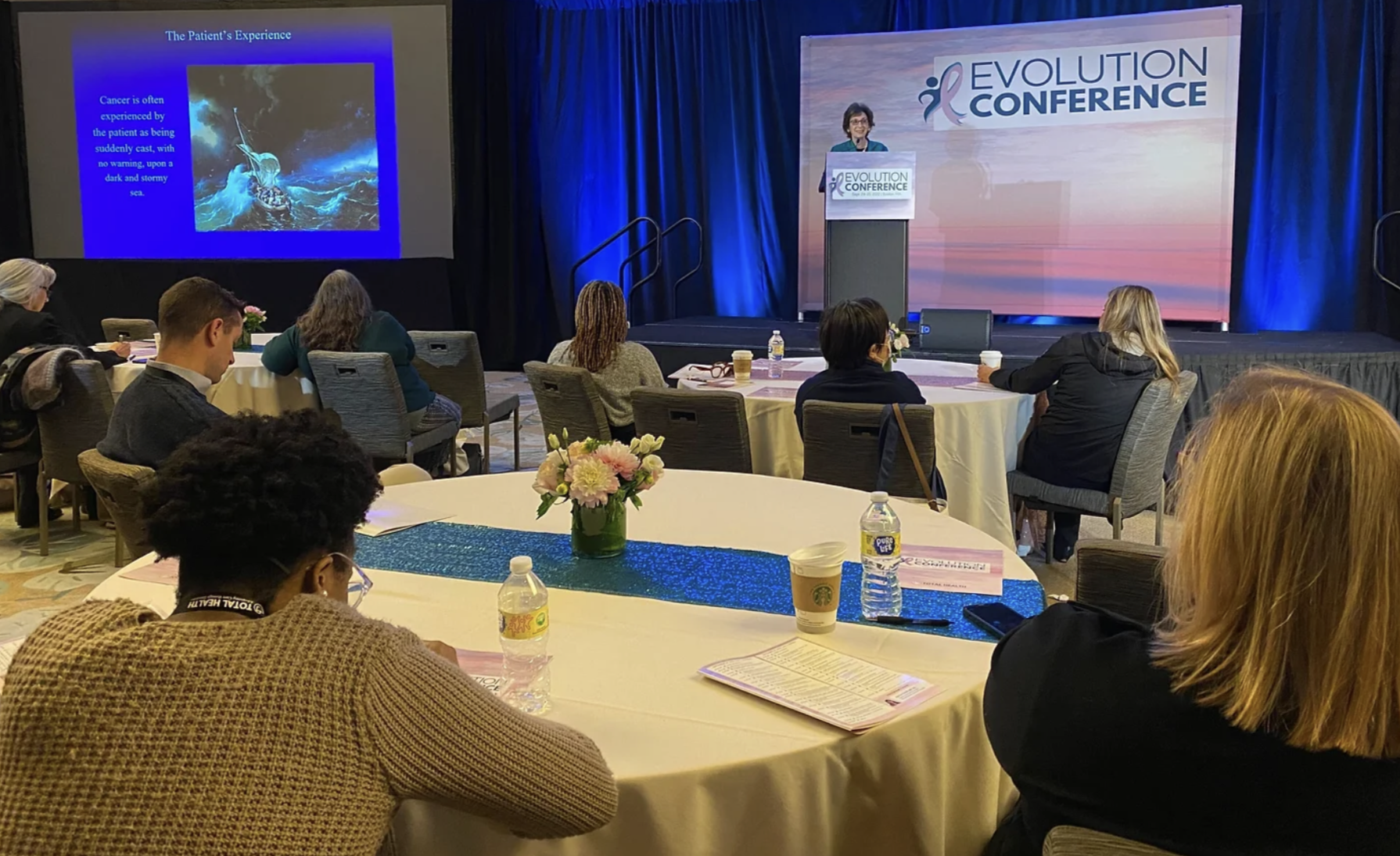Building a Better Patient Relationship: Harness Your Empathic Listening Power!
Dr. Joan Klagsbrun, Focusing-Oriented Therapy, presents during the 2022 Evolution Conference in Boston, MA.
At this year’s ‘Evolution’ educational conference, Joan Klagsbrun, PhD outlined her strategies to help alleviate patient suffering in cancer, and build a more effective clinician-patient relationship. Dr Klagsbrun emphasized that effective cancer care encompasses 2 main components, first, effective diagnosis and treatment, and second, a positive clinician-patient relationship.
She related the metaphor that getting a cancer diagnosis, for the patient, is often like being cast without any warning, on a dark and stormy sea, and that the role of the clinician is to help the patient navigate this difficult journey, and to provide aid and comfort along the way. She outlined the principles for what she calls ‘empathic listening’, noting that the work “empathy” in Greek means “to suffer with”. The main components of empathic listening are an ability to perceive what the patient might be experiencing, and to respond, both verbally and non-verbally, so that the patient feels like they have been seen and heard. The non-verbal responses, she notes, can include things like facial expressions, eye contact, your tone of voice, and your body language. She also noted that it is important to encourage a bi-directional communication with the patient.
Dr Klagsbrun notes that empathic listening can, of course, be more difficult today due to barriers such as electronic record keeping, time constraints, and other unreasonable performance expectations on the clinician’s end. She also related that medical schools often do not provide sufficient training for clinicians in this kind of relationship-centered communication with patients. To help overcome these barriers, Dr Klagsbrun suggests that you check in with yourself first, before even meeting with the patient. One way she suggested is a short, mindful meditation, or deep breathing exercises before the meeting (e.g., in through your nose for a four count, out through your mouth for an eight count), to allow yourself to focus, and be fully present for the patient’s visit. Next, you can set the tone for the meeting by conveying warmth and an attitude of acceptance for the patient; also, try to empower the patient by asking what is important for them, that they would like to discuss with you in this visit. Once you have done so, it is important to reflect back your understanding of their priorities, so they can know that you have heard them.
Other techniques she outlined include expressing some genuine curiosity about the patient’s life (e.g., “what activities do you [or did you] usually enjoy?”), and provide support for their struggle and hardship, with statement’s like “I realize you’re having a hard time right now… We’re going to help you make it through this…” In closing the visit, she emphasizes, convey a positive and supportive comment like “We’ll be sure and check in on this [new issue or concern] at your next visit”, or “Is there anything we might have missed today?”
Dr Klagsbrun outlined some of the key benefits of implementing an empathic listening approach with your patients, including a feeling of acknowledgement by patients when you don’t just understand their illness, but also the patient living behind the illness, and respond to them with due compassion. She also noted the ample evidence from peer-reviewed studies showing that treatment that is stoic and completely devoid of any compassion is more likely to have a poorer outcome, as patients may lose trust in their clinicians, and/or be less compliant with their treatment plans. Conversely, implementing an empathic listening approach can help reduce patient anxiety, build trust, and help patients to make better and more informed decisions about their treatment.
Dr Klagsbrun notes that implementing tools in your practice, such as the “Patient Care Inventory” (as developed by Helen Reiss, MD, author of The Empathy Effect) can also be a useful means to assess how your patients are feeling about their interactions with you. As a final takeaway, she emphasized that, in cancer as in all medicine, the quality of your relationship with your patient is a critical component of their treatment, noting the words of Sir William Osler, MD: “The good physician treats the disease; the great physician treats the patient who has the disease.”
For further reading on this topic, Dr Klagsbrun recommends: In Shock: My Journey from Death to Recovery and the Redemptive Power of Hope by critical care physician, Dr Rana Awdish. “She offers a brave road map for anyone navigating illness, while presenting physicians with a new paradigm and rationale for embracing the emotional bond between doctor and patient.”
You can see Dr Klagsbrun’s full presentation here:

